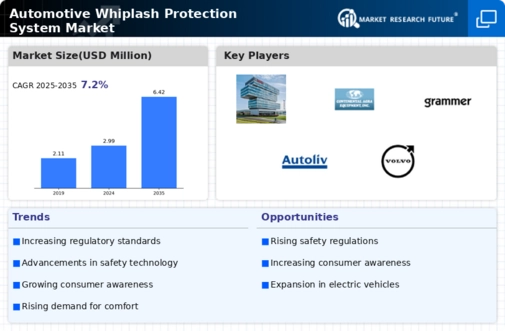Automotive Whiplash Protection System Size
Automotive Whiplash Protection System Market Growth Projections and Opportunities
The automotive industry's focus on safety has led to the development and integration of advanced systems like Whiplash Protection Systems (WPS) into vehicles. The market dynamics of the Automotive Whiplash Protection System market exhibit an intriguing interplay of various factors driving its growth. One of the primary drivers is the increasing awareness among consumers and regulatory bodies regarding the importance of safety features in vehicles. With a rising number of road accidents globally, there's a heightened emphasis on technologies that can mitigate injuries, particularly those related to whiplash, a common injury in rear-end collisions.
Furthermore, the evolving regulatory landscape plays a pivotal role in shaping the market dynamics of WPS. Governments across the globe are implementing stringent safety standards, mandating the inclusion of such systems in vehicles. These regulations not only drive the adoption of WPS but also push automotive manufacturers to innovate and enhance the effectiveness of these systems, fostering healthy competition in the market.
The technological advancements in automotive safety have significantly impacted the WPS market dynamics. Automakers are investing heavily in research and development to introduce more sophisticated and efficient WPS designs. This technological evolution includes the integration of smart sensors, adaptive head restraints, and advanced seat structures, aimed at providing enhanced protection and comfort to occupants during sudden impact events.
Consumer preferences and behavior also influence the market dynamics of WPS. As safety becomes a top priority for car buyers, there's a growing demand for vehicles equipped with comprehensive safety features, including robust whiplash protection systems. Moreover, the increasing disposable income in emerging economies has contributed to a higher willingness among consumers to invest in vehicles with advanced safety technologies, further propelling the market growth.
The competitive landscape within the automotive WPS market is characterized by intense rivalry among key players striving to gain a competitive edge. Companies are focusing on strategic collaborations, mergers, and acquisitions to expand their product portfolios and global presence. Additionally, partnerships with automotive manufacturers to integrate WPS into new vehicle models and aftermarket sales channels have become essential strategies to capture a larger market share.
Global economic trends and macroeconomic factors also influence the market dynamics of automotive WPS. Fluctuations in economic conditions, currency exchange rates, and raw material prices can impact manufacturing costs and, subsequently, the pricing and profitability of WPS solutions. Moreover, geopolitical tensions and trade policies can create uncertainties affecting the supply chain and market growth.
Looking ahead, the automotive WPS market is poised for substantial growth, driven by ongoing technological innovations, regulatory mandates, and increasing consumer awareness. However, challenges such as high initial costs, especially for advanced WPS, and the need for standardization across regions remain pertinent. Nevertheless, as safety continues to be a paramount concern for both consumers and regulatory bodies, the market for Automotive Whiplash Protection Systems is expected to witness steady expansion in the foreseeable future.









Leave a Comment